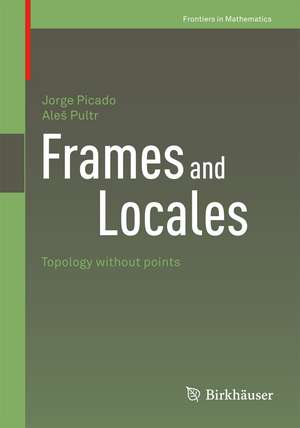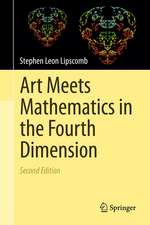Frames and Locales: Topology without points: Frontiers in Mathematics
Autor Jorge Picado, Aleš Pultren Limba Engleză Paperback – 22 oct 2011
Imitating the behaviour of open sets and their relations led to a new approach to topology flourishing since the end of the fifties.It has proved to be beneficial in many respects. Neglecting points, only little information was lost, while deeper insights have been gained; moreover, many results previously dependent on choice principles became constructive. The result is often a smoother, rather than a more entangled, theory.
No monograph of this nature has appeared since Johnstone's celebrated Stone Spaces in 1983. The present book is intended as a bridge from that time to the present. Most of the material appears here in book form for the first time or is presented from new points of view. Two appendices provide an introduction to some requisite concepts from order and category theories.
Din seria Frontiers in Mathematics
-
 Preț: 491.98 lei
Preț: 491.98 lei -
 Preț: 397.68 lei
Preț: 397.68 lei -
 Preț: 399.60 lei
Preț: 399.60 lei - 15%
 Preț: 490.14 lei
Preț: 490.14 lei -
 Preț: 400.71 lei
Preț: 400.71 lei -
 Preț: 398.72 lei
Preț: 398.72 lei -
 Preț: 416.38 lei
Preț: 416.38 lei -
 Preț: 402.16 lei
Preț: 402.16 lei -
 Preț: 396.64 lei
Preț: 396.64 lei - 15%
 Preț: 649.77 lei
Preț: 649.77 lei -
 Preț: 485.18 lei
Preț: 485.18 lei -
 Preț: 417.30 lei
Preț: 417.30 lei - 15%
 Preț: 703.85 lei
Preț: 703.85 lei -
 Preț: 420.02 lei
Preț: 420.02 lei -
 Preț: 449.35 lei
Preț: 449.35 lei -
 Preț: 426.72 lei
Preț: 426.72 lei -
 Preț: 422.90 lei
Preț: 422.90 lei -
 Preț: 416.34 lei
Preț: 416.34 lei -
 Preț: 417.30 lei
Preț: 417.30 lei -
 Preț: 414.42 lei
Preț: 414.42 lei -
 Preț: 419.21 lei
Preț: 419.21 lei -
 Preț: 437.34 lei
Preț: 437.34 lei -
 Preț: 417.81 lei
Preț: 417.81 lei -
 Preț: 518.25 lei
Preț: 518.25 lei -
 Preț: 425.08 lei
Preț: 425.08 lei -
 Preț: 482.56 lei
Preț: 482.56 lei -
 Preț: 457.03 lei
Preț: 457.03 lei - 15%
 Preț: 704.17 lei
Preț: 704.17 lei -
 Preț: 448.38 lei
Preț: 448.38 lei -
 Preț: 419.59 lei
Preț: 419.59 lei -
 Preț: 514.00 lei
Preț: 514.00 lei -
 Preț: 432.51 lei
Preț: 432.51 lei -
 Preț: 426.34 lei
Preț: 426.34 lei -
 Preț: 419.43 lei
Preț: 419.43 lei -
 Preț: 487.37 lei
Preț: 487.37 lei -
 Preț: 415.39 lei
Preț: 415.39 lei -
 Preț: 427.33 lei
Preț: 427.33 lei -
 Preț: 276.84 lei
Preț: 276.84 lei -
 Preț: 422.90 lei
Preț: 422.90 lei -
 Preț: 422.90 lei
Preț: 422.90 lei -
 Preț: 423.29 lei
Preț: 423.29 lei -
 Preț: 422.90 lei
Preț: 422.90 lei -
 Preț: 416.54 lei
Preț: 416.54 lei -
 Preț: 424.22 lei
Preț: 424.22 lei -
 Preț: 420.02 lei
Preț: 420.02 lei -
 Preț: 419.59 lei
Preț: 419.59 lei -
 Preț: 467.64 lei
Preț: 467.64 lei -
 Preț: 496.72 lei
Preț: 496.72 lei -
 Preț: 422.11 lei
Preț: 422.11 lei
Preț: 459.92 lei
Nou
Puncte Express: 690
Preț estimativ în valută:
88.01€ • 91.70$ • 72.87£
88.01€ • 91.70$ • 72.87£
Carte tipărită la comandă
Livrare economică 03-17 aprilie
Preluare comenzi: 021 569.72.76
Specificații
ISBN-13: 9783034801539
ISBN-10: 303480153X
Pagini: 420
Ilustrații: XIX, 398 p.
Dimensiuni: 168 x 240 x 22 mm
Greutate: 0.54 kg
Ediția:2012
Editura: Springer
Colecția Birkhäuser
Seria Frontiers in Mathematics
Locul publicării:Basel, Switzerland
ISBN-10: 303480153X
Pagini: 420
Ilustrații: XIX, 398 p.
Dimensiuni: 168 x 240 x 22 mm
Greutate: 0.54 kg
Ediția:2012
Editura: Springer
Colecția Birkhäuser
Seria Frontiers in Mathematics
Locul publicării:Basel, Switzerland
Public țintă
ResearchCuprins
Preface.- Introduction.- I. Spaces and lattices of open sets.- II. Frames and locales. Spectra.- III. Sublocales.- IV. Structure of localic morphisms. The categories Loc and Frm.- V. Separation axioms.- VI. More on sublocales.-VII. Compactness and local compactness.- VIII. (Symmetric) uniformity and nearness.- IX. Paracompactness.- X. More about completion.- XI. Metric frames.- XII. Entourages, non-symmetric uniformity.- XIII. Connectedness.- XIV. The frame of reals and real functions.- XV. Localic groups.- Appendix I: Posets.- Appendix II: Categories.- Bibliography.- Index of Notation.- Index.
Recenzii
From the reviews:
“The book covers, in a comprehensive and self-contained way, the development of point-free topology in the last 30 years … . The book ends with two short appendices containing those facts about partially ordered sets and categories needed in the book. In conclusion, this is a very good book; it is nicely written and is highly recommended for anyone wishing to gain an overview of point-free topology.” (Javier Gutiérrez García, Mathematical Reviews, Issue 2012 j)
“The book starts with a recount of sobriety and the TD-axiom, which is then quickly followed by the definition of the category of locales, various facets of spectra, the usual adjunctions and several criteria for spatiality. … this book is an erudite account of the current status of pointfree topology, written beautifully in the authors’ inimitable style. It is both easily accessible to a complete beginner, and an excellent source of reference for the mature pointfree practitioner.” (Themba Dube, Zentralblatt MATH, Vol. 1231, 2012)
“In a total of fifteen chapters the reader is taken from spaces and lattices of open sets, through a thorough discussion of the notions of frames and locales … . book ends (modulo its appendices) with a discussion of localic groups … together with frames, that’s what this entire book is ultimately all about. … is quite-well written: it’s a clear and thorough treatment of what is really rather an important subject, which is to say, a greatly underappreciated one.” (Michael Berg, The Mathematical Association of America, April, 2012)
“The book covers, in a comprehensive and self-contained way, the development of point-free topology in the last 30 years … . The book ends with two short appendices containing those facts about partially ordered sets and categories needed in the book. In conclusion, this is a very good book; it is nicely written and is highly recommended for anyone wishing to gain an overview of point-free topology.” (Javier Gutiérrez García, Mathematical Reviews, Issue 2012 j)
“The book starts with a recount of sobriety and the TD-axiom, which is then quickly followed by the definition of the category of locales, various facets of spectra, the usual adjunctions and several criteria for spatiality. … this book is an erudite account of the current status of pointfree topology, written beautifully in the authors’ inimitable style. It is both easily accessible to a complete beginner, and an excellent source of reference for the mature pointfree practitioner.” (Themba Dube, Zentralblatt MATH, Vol. 1231, 2012)
“In a total of fifteen chapters the reader is taken from spaces and lattices of open sets, through a thorough discussion of the notions of frames and locales … . book ends (modulo its appendices) with a discussion of localic groups … together with frames, that’s what this entire book is ultimately all about. … is quite-well written: it’s a clear and thorough treatment of what is really rather an important subject, which is to say, a greatly underappreciated one.” (Michael Berg, The Mathematical Association of America, April, 2012)
Textul de pe ultima copertă
Until the mid-twentieth century, topological studies were focused on the theory of suitable structures on sets of points. The concept of open set exploited since the 1920s offered an expression of the geometric intuition of a "realistic" place (spot, grain) of non-trivial extent.
Imitating the behaviour of open sets and their relations led to a new approach to topology flourishing since the end of the 1950s. It has proved to be beneficial in many respects. Neglecting points, only little information was lost, while deeper insights have been gained; moreover, many results previously dependent on choice principles became constructive. The result is often a smoother, rather than a more entangled, theory.
No monograph of this nature has appeared since Johnstone's celebrated Stone Spaces in 1983. The present book is intended as a bridge from that time to the present. Most of the material appears here in book form for the first time or is presented from new points of view. Two appendices provide an introduction to some requisite concepts from order and category theories.
Imitating the behaviour of open sets and their relations led to a new approach to topology flourishing since the end of the 1950s. It has proved to be beneficial in many respects. Neglecting points, only little information was lost, while deeper insights have been gained; moreover, many results previously dependent on choice principles became constructive. The result is often a smoother, rather than a more entangled, theory.
No monograph of this nature has appeared since Johnstone's celebrated Stone Spaces in 1983. The present book is intended as a bridge from that time to the present. Most of the material appears here in book form for the first time or is presented from new points of view. Two appendices provide an introduction to some requisite concepts from order and category theories.
Caracteristici
First monograph in this area in more than two decades Most of the material has not yet been published in book form, particularly the part devoted to the enriched structures Suitable for advanced courses and as a reference text Includes supplementary material: sn.pub/extras














